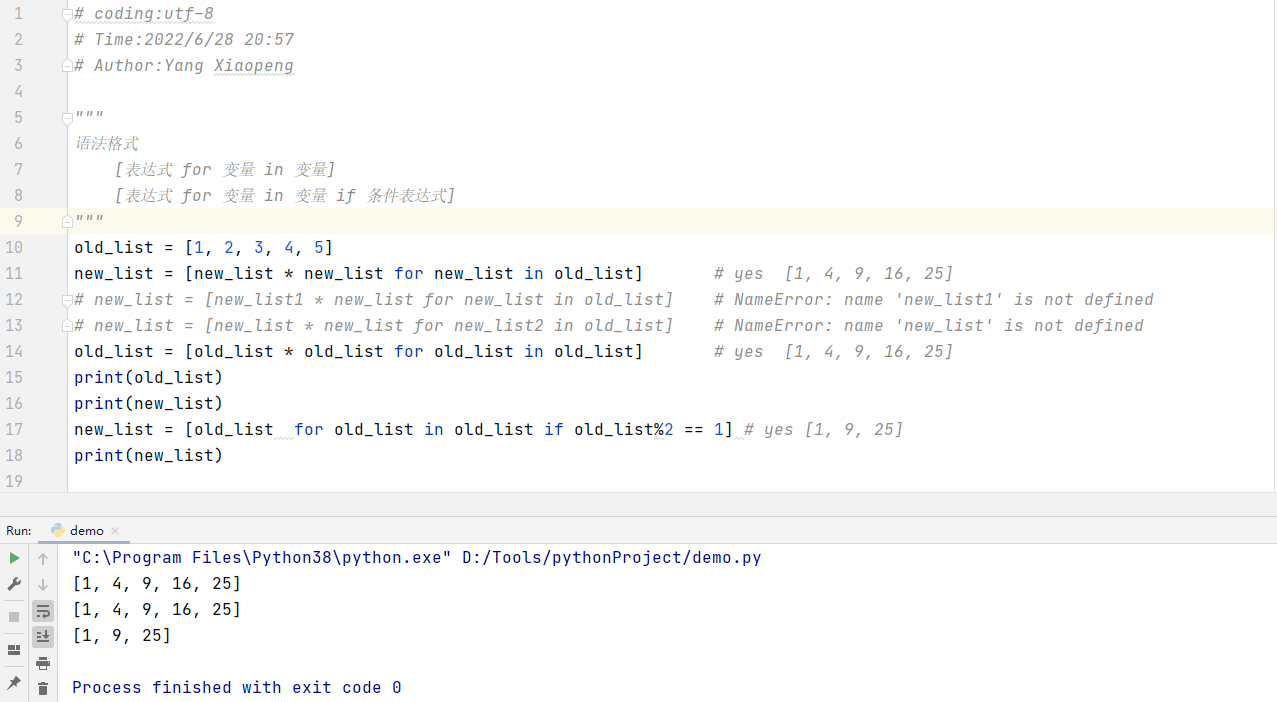жӮЁеҘҪпјҢзҷ»еҪ•еҗҺжүҚиғҪдёӢи®ўеҚ•е“ҰпјҒ
жӮЁеҘҪпјҢзҷ»еҪ•еҗҺжүҚиғҪдёӢи®ўеҚ•е“ҰпјҒ
д»ҠеӨ©е°Ҹзј–з»ҷеӨ§е®¶еҲҶдә«дёҖдёӢPythonжҺЁеҜјејҸж•°жҚ®еӨ„зҗҶж–№ејҸжҳҜд»Җд№Ҳзҡ„зӣёе…ізҹҘиҜҶзӮ№пјҢеҶ…е®№иҜҰз»ҶпјҢйҖ»иҫ‘жё…жҷ°пјҢзӣёдҝЎеӨ§йғЁеҲҶдәәйғҪиҝҳеӨӘдәҶи§Јиҝҷж–№йқўзҡ„зҹҘиҜҶпјҢжүҖд»ҘеҲҶдә«иҝҷзҜҮж–Үз« з»ҷеӨ§е®¶еҸӮиҖғдёҖдёӢпјҢеёҢжңӣеӨ§е®¶йҳ…иҜ»е®ҢиҝҷзҜҮж–Үз« еҗҺжңүжүҖ收иҺ·пјҢдёӢйқўжҲ‘们дёҖиө·жқҘдәҶи§ЈдёҖдёӢеҗ§гҖӮ
жҺЁеҜјејҸжҳҜдёҖз§ҚзӢ¬зү№зҡ„ж•°жҚ®еӨ„зҗҶж–№ејҸпјҢеҸҜд»Ҙеҝ«йҖҹзҡ„д»ҺдёҖдёӘж•°жҚ®еәҸеҲ—жһ„е»әеҸҰдёҖдёӘж–°зҡ„ж•°жҚ®еәҸеҲ—зҡ„з»“жһ„дҪ“гҖӮеёёз”Ёзҡ„жҺЁеҜјејҸжңүдёҖдёӢеӣӣз§Қпјҡ
еҲ—иЎЁжҺЁеҜјејҸ
е…ғз»„жҺЁеҜјејҸ
йӣҶеҗҲжҺЁеҜјејҸ
еӯ—е…ёжҺЁеҜјејҸ
# coding:utf-8 # Author:Yang Xiaopeng """ иҜӯжі•ж јејҸ [иЎЁиҫҫејҸ for еҸҳйҮҸ in еҸҳйҮҸ] [иЎЁиҫҫејҸ for еҸҳйҮҸ in еҸҳйҮҸ if жқЎд»¶иЎЁиҫҫејҸ] дёҠиҝ°ж јејҸдёӯ зҡ„ иЎЁиҫҫејҸдёӯзҡ„еҸҳйҮҸдёҺforеҸҳйҮҸдёҖиҮҙ """ old_list = [1, 2, 3, 4, 5] new_list = [new_list * new_list for new_list in old_list] # yes [1, 4, 9, 16, 25] # new_list = [new_list1 * new_list for new_list in old_list] # NameError: name 'new_list1' is not defined # new_list = [new_list * new_list for new_list2 in old_list] # NameError: name 'new_list' is not defined old_list = [old_list * old_list for old_list in old_list] # yes [1, 4, 9, 16, 25] print(old_list) print(new_list) new_list = [old_list for old_list in old_list if old_list%2 == 1] # yes [1, 9, 25] print(new_list)

# coding:utf-8
# Author:Yang Xiaopeng
"""
иҜӯжі•ж јејҸ
(иЎЁиҫҫејҸ for еҸҳйҮҸ in еҸҳйҮҸ)
(иЎЁиҫҫејҸ for еҸҳйҮҸ in еҸҳйҮҸ if жқЎд»¶иЎЁиҫҫејҸ)
дёҠиҝ°ж јејҸдёӯ зҡ„ иЎЁиҫҫејҸдёӯзҡ„еҸҳйҮҸдёҺforеҸҳйҮҸдёҖиҮҙ
"""
old_list = (1, 2, 3, 4, 5)
new_list = (new_list * new_list for new_list in old_list) # yes 1_4_9_16_25_
# new_list = [new_list1 * new_list for new_list in old_list] # NameError: name 'new_list1' is not defined
# new_list = [new_list * new_list for new_list2 in old_list] # NameError: name 'new_list' is not defined
old_list = (old_list * old_list for old_list in old_list) # yes 1_4_9_16_25_
for item in new_list:
print(item, end="_")
print("")
for item in old_list:
print(item, end="_")
print("")
# coding:utf-8
# Time:2022/6/28 20:57
# Author:Yang Xiaopeng
"""
иҜӯжі•ж јејҸ
{иЎЁиҫҫејҸ for еҸҳйҮҸ in еҸҳйҮҸ}
{иЎЁиҫҫејҸ for еҸҳйҮҸ in еҸҳйҮҸ if жқЎд»¶иЎЁиҫҫејҸ}
дёҠиҝ°ж јејҸдёӯ зҡ„ иЎЁиҫҫејҸдёӯзҡ„еҸҳйҮҸдёҺforеҸҳйҮҸдёҖиҮҙ
"""
old_list = {1, 2, 3, 4, 5}
new_list = {new_list * new_list for new_list in old_list} # yes {1, 4, 9, 16, 25}
# new_list = {new_list1 * new_list for new_list in old_list} # NameError: name 'new_list1' is not defined
# new_list = {new_list * new_list for new_list2 in old_list} # NameError: name 'new_list' is not defined
old_list = {old_list * old_list for old_list in old_list} # yes {1, 4, 9, 16, 25}
print(old_list)
print(new_list)
new_list = {old_list for old_list in old_list if old_list % 2 == 1} # yes {1, 9, 25}
print(new_list)
# coding:utf-8
# Author:Yang Xiaopeng
"""
иҜӯжі•ж јејҸ
{key : value for key in еҸҳйҮҸ}
{key : value for key in еҸҳйҮҸ if иЎЁиҫҫејҸ}
"""
old_dict = ["Zhang", "Wang", "Yang", "Jim"]
new_dict = {key:len(key) for key in old_dict} # yes {1, 4, 9, 16, 25}
print(old_dict)
print(new_dict)
new_dict = {lll:len(lll) for lll in old_dict if len(lll) % 2 == 0} # yes {1, 9, 25}
print(new_dict)
д»ҘдёҠе°ұжҳҜвҖңPythonжҺЁеҜјејҸж•°жҚ®еӨ„зҗҶж–№ејҸжҳҜд»Җд№ҲвҖқиҝҷзҜҮж–Үз« зҡ„жүҖжңүеҶ…е®№пјҢж„ҹи°ўеҗ„дҪҚзҡ„йҳ…иҜ»пјҒзӣёдҝЎеӨ§е®¶йҳ…иҜ»е®ҢиҝҷзҜҮж–Үз« йғҪжңүеҫҲеӨ§зҡ„收иҺ·пјҢе°Ҹзј–жҜҸеӨ©йғҪдјҡдёәеӨ§е®¶жӣҙж–°дёҚеҗҢзҡ„зҹҘиҜҶпјҢеҰӮжһңиҝҳжғіеӯҰд№ жӣҙеӨҡзҡ„зҹҘиҜҶпјҢиҜ·е…іжіЁдәҝйҖҹдә‘иЎҢдёҡиө„и®Ҝйў‘йҒ“гҖӮ
е…ҚиҙЈеЈ°жҳҺпјҡжң¬з«ҷеҸ‘еёғзҡ„еҶ…е®№пјҲеӣҫзүҮгҖҒи§Ҷйў‘е’Ңж–Үеӯ—пјүд»ҘеҺҹеҲӣгҖҒиҪ¬иҪҪе’ҢеҲҶдә«дёәдё»пјҢж–Үз« и§ӮзӮ№дёҚд»ЈиЎЁжң¬зҪ‘з«ҷз«ӢеңәпјҢеҰӮжһңж¶үеҸҠдҫөжқғиҜ·иҒ”зі»з«ҷй•ҝйӮ®з®ұпјҡis@yisu.comиҝӣиЎҢдёҫжҠҘпјҢ并жҸҗдҫӣзӣёе…іиҜҒжҚ®пјҢдёҖз»ҸжҹҘе®һпјҢе°Ҷз«ӢеҲ»еҲ йҷӨж¶үе«ҢдҫөжқғеҶ…е®№гҖӮ